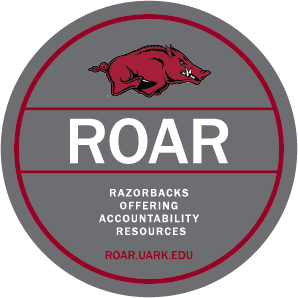Facts
Of college students in the age range from 18 to 22:
- 60.1% drink alcohol in any particular month
- 39.0% engage in binge drinking each month
- 13.2% engage in heavy alcohol use each month¹
- June through October are the months with the highest rates of alcohol use by college students²
- 22.5% of men and 15.5% of women between the ages of 21 to 25 have driven while under the influence of alcohol (within a 1-year timeframe)
- From 2002 to 2014, the percent of drivers who are age 16 and older who have driven under the influence of alcohol in the past year has decreased from 15.3% to 11.1%³
- 77.1% of college student-athletes drank alcohol within the last year – compared with between 78.9% and 81.3% of similar age young adults (Schulenberg et al., 2016; SIUC/Core Institute, 2013)
- 42% of college student-athletes binge drank within the last year (which is a decrease from 2009 – 55%)4
| UARK | National | |
| Consume 4 or fewer drinks when they party or socialize | 58.4% | 59.1% |
| Report “binge drinking”, defined as 5 or more drinks in a two-hour time period | 33.8% | 29.7% |
National College Health Assessment (NCHA) 2017
Most Common High-Risk Behaviors While Drinking
| UARK | National | |
| Pregaming | 52% | 50% |
| Doing shots | 44% | 48% |
| Chugging alcohol | 24% | 26% |
Alcohol Edu (2016-17)
Most Common Negative Consequences Experienced While Drinking
| UARK | National | |
| Blacked out | 41% | 34% |
| Passed out | 23% | 18% |
| Hangover | 53% | 47% |
| Poor performance on assignment | 26% | 19% |
Alcohol Edu (2016-17)
Student Reasons for not drinking:
- Going to drive – 67%
- Don’t want to spend the money – 36%
- Have other things to do – 36%
- Don’t have to drink to have a good time – 29%
- Don’t want to lose control – 29%
Alcohol Edu (2016-17)
Citations:
- Lipari, R. N., & Jean-Francois, B. (2016, May 26). A day in the life of college students aged 18 to22: Substance use facts (Short Report). Rockville, MD: Substance Abuse and Mental Health Services Administration. (SAMHSA).
- Substance Abuse and Mental Health Services Administration. (SAMHSA). Data and tables.
- Lipari, R. N., Hughes, A., & Bose, J. (2016). Driving under the influence of alcohol and illicit drugs (Short Report). Rockville, MD: Substance Abuse and Mental Health Services Administration. (SAMHSA).
- Cook, M., Radford, C., & Durham, M. (2018). NCAA national study on substance use habits of college student-athletes. Indianapolis, IN: NCAA.
